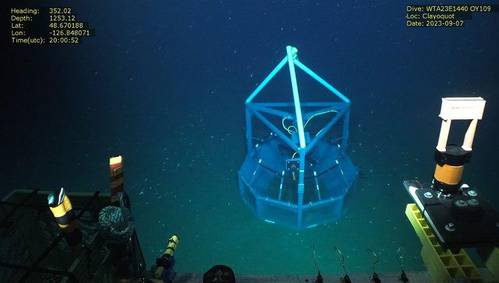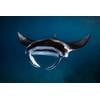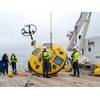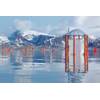ONC’s Deep Sea Observatory Supporting Ocean-based CO2 Removal Research
Ocean Networks Canada’s deep sea observatory is the research monitoring site for a new type of ocean-based carbon dioxide removal technology; the first of its kind to be trialed in Canadian waters.
The research experiment is a partnership between ONC and the U.S.-based ocean health company Running Tide to advance scientific knowledge of marine carbon dioxide removal (mCDR) and provide foundational information on the potential to enhance natural ocean carbon removal processes.
An observational platform outfitted with Running Tide’s Carbon Buoys was successfully installed by Pelagic Research Service’s remotely operated vehicle (ROV) Odysseus at the Clayoquot Slope site on ONC’s NEPTUNE seafloor observatory, located off the west coast of Canada, during the current ONC Abyss expedition. The buoys are made from wood, mycelium, and locally sourced sugar kelp.
According to the U.S. National Academies of Sciences, Engineering, and Medicine, seaweed cultivation could remove around 100 million to 1 billion tons (1 gigaton) of CO2 per year.
Over the next 12 months the project will investigate what happens to carbon-capturing biomass after it sinks to the seafloor and its potential impacts on the deep sea environment as it resides there. Under the spotlight will be Carbon Buoys that are designed to grow algae (or seaweed), and capture and convert CO2 into algal biomass through photosynthesis. Once the buoy reaches a point of negative buoyancy, it sinks to the seafloor.
ONC’s established deep-sea observatories provide a unique ocean-scale laboratory to monitor and assess the efficacy and fate of these sunken Carbon Buoys under immense pressure–1,000s of meters below the surface.
“This experiment will advance the scientific understanding of biomass falls in the benthic environment - a natural, but currently undersampled occurrence,” said Alison Tune, leader of Running Tide’s Earth Science and Ecology team.
“Understanding potential impact to seafloor ecosystems is critical for any carbon removal strategy that plans to durably remove carbon through sinking biomass. Partnering with ONC provides the opportunity to observe a marine environment that is very difficult to access, and will help advance foundational science in this area.”
The observational platform, or benthic lander, was custom-designed by ONC with 18 compartments to house biomass provided by Running Tide more than 1,000 meters below the surface.
“The biggest novelty of our design is that the lander’s shape is a nonagon. A nine-sided frame which includes a centrally mounted camera, capable of imaging 360 degrees,” said Kohen Bauer, ONC senior staff scientist, “This will provide near-real time imagery of the substrates in the environment over the course of the experiment.”
The biomass will also be monitored using environmental sensors (salinity, temperature, and dissolved oxygen). Water and sediment samples will be collected throughout the experiment by remotely operated vehicles to observe potential changes in sediment composition, as well as how the in-situ microbial community might respond to the presence of Carbon Buoys.
This experiment is part of Running Tide’s broader research roadmap to understand the potential impacts on the environment - both positive and intended, but also the local potential risks to the environment. The company says it is critical to understand how the natural materials being deployed will store carbon over time, and to know how these materials may impact organisms and the environment in the immediate vicinity.
ONC president and CEO Kate Moran said ONC is committed to enabling research on ocean-based solutions for climate change mitigation: “The Government of Canada has invested in ONC’s real-time, ocean observing infrastructure, making it the perfect platform to do real-world research of this kind; and positioning Canada to lead the way in Monitoring, Reporting, and Verification (MRV) of ocean CDR research.”
The Intergovernmental Panel on Climate Change (IPCC) Sixth Assessment Report describes how all reasonable scenarios that limit global warming to 1.5°C require large-scale carbon removal at an estimated rate of six to ten gigatons annually by 2050, in addition to deep decarbonization across all economic sectors.
ONC was connected with Running Tide to help advance this mCDR through the Launchpad program by Ocean Visions, a non-profit organization catalyzing innovation at the intersection of the ocean and climate crises.














 August 2025
August 2025



